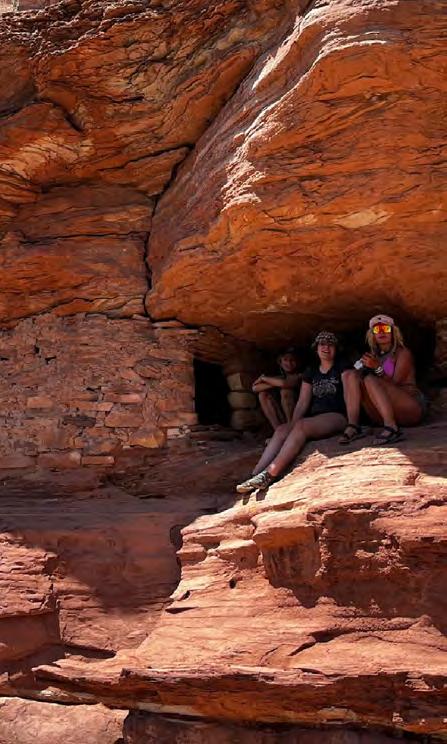
2 minute read
West with Water
from Water in the West
After traversing up the steep cliff for a while, we got to the top overlooking two sides of the river that looped around a large cliff. A long time ago, the river used to just turn right, but over time, the steep terrainblockedthewaterandmadeanew route.ItformedagiantUshape,andonce yougottotheotherside,whichtookhours onasmallcanoe,itlookedlikeyouwerein the same spot. The view at the top was breathtaking. Sharp orange cliffs extended to the horizon where pillowy gray storm clouds were forming. We stayed up there for hours, tucked into small crevasses in the rock to hide from the wind, drawing, and writing. When we finally decided to hikedown,theweatherwasgoodforafew moments, until storm clouds came in. We had to gunnel up on the side of the Green tiedtoabigrock.
We stayed there for a little while, eating PB&Js wrapped in tortillas before the weather calmed down and we continued on.
Advertisement
We were always drawing. Almost every day, I drew something. Every day the landscapechanged,andtherewasalways somethingnewtodraw.Ontheninthday, wehadatwo-hourjetboatridealltheway up the Colorado River back to Moab. I looked at the rocks and decided to open my sketchbook and draw. I had been drawingthingspreciselyasIsawthemthe wholetrip,andwantedtomakesomething moreofmyown.Itookinspirationfromthe rocks,butprimarilyIwasdrawingfrommy imagination. The boat droned on, and people were talking and yelling, but I foundawaytotuneitalloutandjustdraw forawhile.Idrewfantasticalrocksthatthe terrain around me had somehow inspired. The landscape had affected me. In Hansman’s book, Downriver, she talks about a raft guide who often stated, “We save what we love and we love what we know” (2019, p.150). I had come to know the Green River. I want to protect it so otherscanlearnfromittoo.

Throughout the trip, we occasionally saw small remains of Anasazi homes and towers, evidence of a civilization that mismanaged water and paid the ultimate price.Smallstoneigloo-typebuildingswith pieces of wood holding the entrances could hold up to two or three people uncomfortably. Why would they abandon their homes and go somewhere else? No one is entirely sure, but people have their guesses. Jared Diamond, the author of Collapse, believes they overused the water they had. They farmed too much duringthewetseasons,overworking
Thelandcouldnolongerprovideforthem, forcing them to leave. They used up all theirresourcesuntiltherewasnothingleft. Ifwearenotcareful,wewillendupinthe sameplace.Ifwecontinuetousewaterat the rate we are, our dams will reach Deadpool,whichiswhenthewaterlevelis so low that water can't pass through the dams. We need to learn to conserve water,andbuildasustainablerelationship withit,soitcancontinuetoprovideforus, foryearstocome.
The question of how to have a more sustainable relationship with water is a tough question to confidently come up with a solid answer for. I think there are a few solutions that can help. Water banks are an effective way to conserve water. Of the 1.9 trillion gallons of water that the Colorado River basin provides annually, agriculture consumes 80%. Since agriculture is themainuseofwater,ifwetacklethisproblem,it will have the biggest impact. What a water bank does is it works just like a bank, but for water instead. People can put water rights in the bank whentheydon'tneeditandcangettheirincome fromthat.Farmerscanselltheirwatertobeused forotherthingsandcanmakemoneyfromthatif theydecidenottofarmthatyear.Theycouldput their water that normally would go to growing crops and feeding animals into a water bank, which would be a new source of income. If there was any water left over, or some wasn't used, putting it into a water bank would go back to the earth to be used again, and would give the farmerssomemoney.

Waterbanksare,“easytouse,profitable,yetan effective mechanism that enables transfers to both direct flow and stored agricultural water rights” (Heather, 2019, p.190). Things like water banksareagreatstepforward.Peoplecansave water and have reason to do so. It is very importantthatwecontinuetomakethesestepsin the right direction, which is something the Chacoansdidn'tdo.Backthen,theylivedwithout thinking about what the outcome could be. A lot of time has passed since then, and we have a betterunderstandingofwhatwillhappen.Itisour responsibility to make sure we can keep our water.

The tricky and most important part of conserving water is giving people an incentive. I think that this is the most important thing we can do in ordertochangeourrelationship with water. In order for things like the water bank to happen, people need incentives to do so.Nothingisgoingtochangeif no one cares. If we can incentivizepeopletocare,that's when things change. Getting peopletodosoisdifficult,andI don't have a solid answer. Therearelotsofdifferentways.











